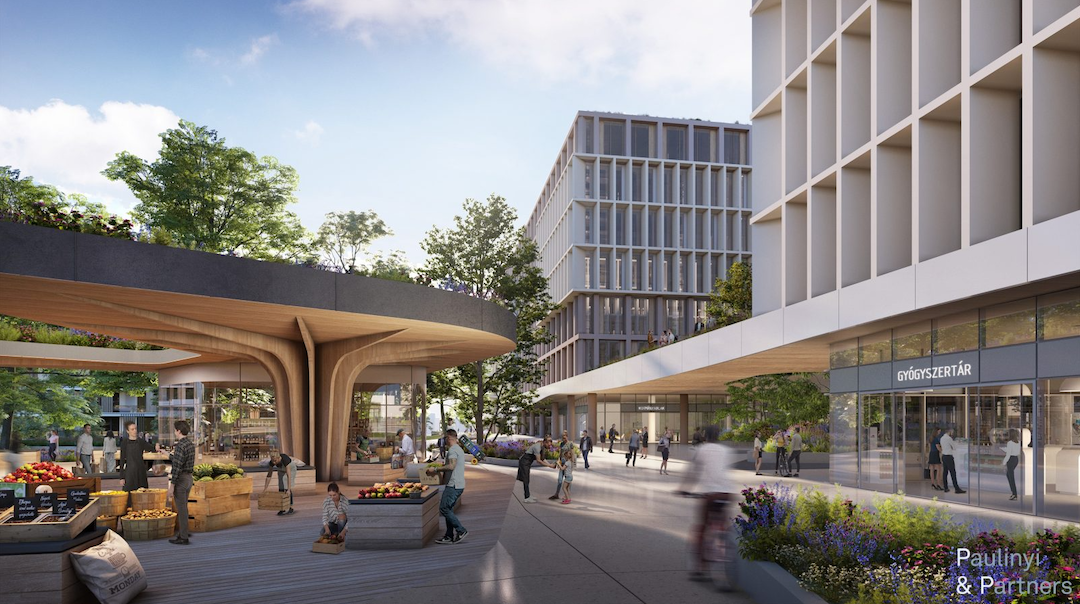Latest News

A Paulinyi & Partners city center design. Photo: Paulinyi & Partners
Hungarian architectural firm Paulinyi & Partners is using satellite technology to improve its work in urban planning and says this collaboration can lead to more climate-resistant designs.
In late 2023, the firm signed a contract with the European Space Agency (ESA) to participate in the ‘Space for Green Construction’ program. As part of the program, Hungarian experts will use EO data from satellites to study the phenomenon of urban microclimate and develop solutions to reduce the urban heat island (UHI) effect.
Gergely Paulinyi, president and CEO of Paulinyi & Partners, told Via Satellite the company has been interested in innovative technologies and space exploration for a long time and has been developing a relationship with the space industry over the last few years. Two years ago, the firm produced a study about the possibilities of designing a lunar base. This design was featured at the International Astronautical Conference in 2022. The IAC study looked at plans for a lunar base that could be built on the Moon using lunar raw materials, namely regolith rock from the surface of the Moon, taking into account the specific thermal and environmental conditions of the Moon, as well as logistical and construction challenges.
With the Space for Green Construction program, the firm has a contractor role with ESA. The firm is leveraging advanced simulation tools to improve the energy efficiency of real estate developments with data from space. The firm is developing a solution called HeatScape Resolve, which uses satellite EO imagery to map UHI effect in order to use this data to improve the effectiveness of existing predictive simulations. The firm aims to connect this to its automated AI based urban design tools.
“Diverse ML solutions are already used for EO data classification tasks, such as tree foliage recognition or built-up area indexing that are directly useful for urbanism,” Paulinyi said. “AI-based automated, continuously updated land use mapping implemented on 3D urban model level would be incredibly useful for the architecture industry and land administration, and we believe we will get there soon.”
While satellite data has proven useful in sectors like agriculture, where EO is used for drought monitoring, Paulinyi believes its potential in built-up environments and construction sectors remains underutilized.
Paulinyi believes HeatScape Resolve can have an impact by comparing the current satellite imagery with simulation results of the current condition. The company will use it to create more precise simulations for the planned condition of the urban development.
“Based on the results, our firm will analyze the urban plans for its clients to mitigate the effects of urban heat islands. Once the asset is built, Paulinyi & Partners will be able to utilize satellite imagery to monitor the outcomes and, if deemed necessary, employ it as a basis for implementing additional measures such as greenery, water features, and additional shading,” he said.
While the company is based in Hungary, it is investigating the market demand for the service while in development and is in consultation with multiple countries across Europe, including Italy and Poland.
“The goal is to use satellite data to help municipalities create climate-resilient neighborhoods. Our firm envisions this collaboration as a stepping stone toward long-term cooperation with urban planners, offering a data-driven approach to designing cities that can better withstand the impacts of climate change,” Paulinyi said.
Paulinyi talks about the issue of urban heat island intensity, which describes the temperature difference between urban areas and their surroundings, which can range from 1 to 16 degrees Celsius in European cities, depending on the region’s climate. He said this effect is especially strong during summer months, particularly in Mediterranean cities, where rising temperatures due to climate change are exacerbating the issue. He said this impacts almost all walks of life, and he believes it will pose one of the key challenges in the construction industry in the near future.
“In Budapest, Hungary UHI impact is shown to be between 0 to 6 degrees Celsius. While this effect can reduce heating demands, it significantly increases the need for cooling, which is expected to cause a 60% rise in CO2 emissions by 2050. This ratio probably will be even more drastic in warmer climate areas. Certain socioeconomic groups are disproportionately more affected, but it does affect everyone ultimately. We are certainly in a situation when new solutions are needed to make people’s lives easier,” he added.
He sees potential for satellite imagery to inform more data products for urban planning.
“Space data in a more general sense can link the physical urban environment more precisely to digital models and enable verifiable real-time data sharing on buildings, allowing for better energy management, construction monitoring, and sustainable design practices. For Hungary to stay competitive and forward-thinking, embracing these technologies will be essential to driving both economic and ecological progress,” Paulinyi said.
Get the latest Via Satellite news!
Subscribe Now